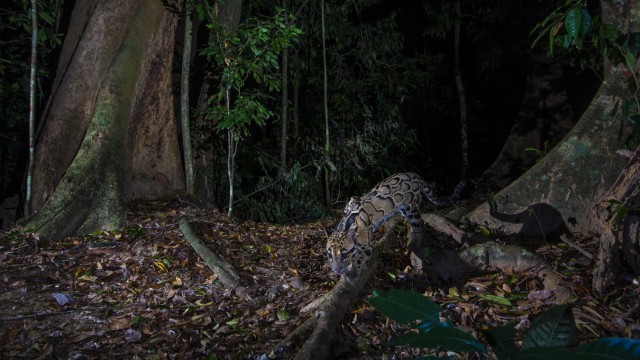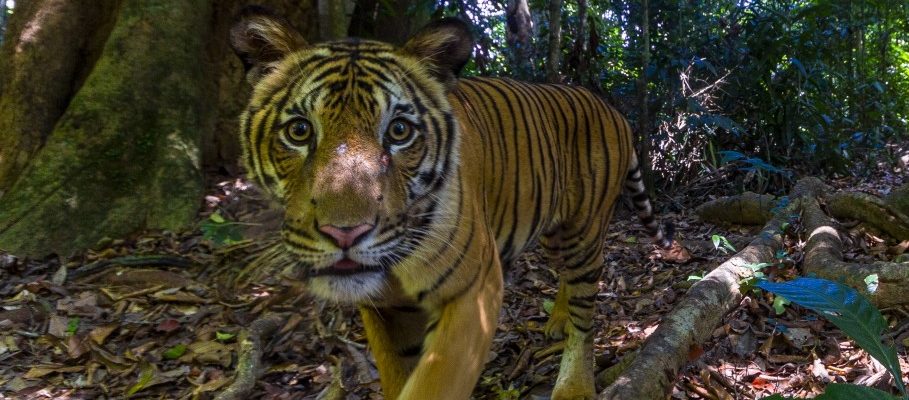The Malaysian tiger is one of the rarest mammals in the world. It is estimated that only around 150 individuals still live in the forests of the Malay Peninsula. It is not known exactly how many there are because it is extremely difficult to see the large cats. The fact that nature photographer Emmanuel Rondeau, together with a team from the nature conservation organization WWF, managed to take photos of one of the last specimens in its natural habitat at least proves that the animals still exist. “It gives us hope that efforts to protect tigers are not in vain,” said Markus Radday, tiger expert at WWF, in a press statement.
You can’t say it was easy to record. The preparations for the project alone took several months: Among other things, suitable locations had to be found for the camera traps, which Rondeau set up in the north of the peninsula with the help of a local support team.
A WWF employee installs a camera trap.
(Photo: Emmanuel Rondeau; Emmanuel Rondeau /WWF-US/Emmanuel Rondeau)
Rondeau had to be patient until he got the snapshot of the tiger, which looks surprised and somewhat confused directly into the camera. The team that regularly checked and maintained the cameras was able to pass the time with other interesting animals that fell into one of the camera traps one after the other: including an eager black-backed tapir at night.

Malayan tapirs are not quite as rare as Malaysian tigers, but are considered critically endangered.
(Photo: Emmanuel Rondeau; Emmanuel Rondeau /WWF-US/Emmanuel Rondeau)
The vegetarians, which weigh up to 540 kilograms, are also on the Red List of the International Union for Conservation of Nature (IUCN) and are classified there as highly endangered. The black-backed tapir is well camouflaged by the black and white pattern of its fur. Its enemies, which probably include the tiger, can hardly see the black parts of the fur at night and therefore do not recognize the tapir as prey.
A clouded leopard also walked in front of the camera, balancing intently on a tree trunk and not even noticing that it was being filmed.

Clouded leopards can not only balance well, but can also hang upside down on branches.
(Photo: Emmanuel Rondeau; Emmanuel Rondeau /WWF-US/Emmanuel Rondeau)
But this balancing act is nothing for a clouded leopard. It is known from observations in zoos that the animals can run head first down tree trunks. Occasionally they hang down from branches using only their hind paws. Little is known about how these shy animals live in the wild. What we do know is that they travel both day and night.
At some point a sun bear wandered into one of Rondeau’s camera traps.

Sun bears change their facial expressions when another bear looks at them.
(Photo: Emmanuel Rondeau; Emmanuel Rondeau /WWF-US/Emmanuel Rondeau)
The animal with the characteristic light snout is also called the sun bear – probably because the bears, which can grow up to 1.40 meters in size, like to bathe in the sun. Sun bears build nests in trees where they sleep during the day. Like primates and dogs, sun bears change their facial expressions when another sun bear looks at them.
Then at some point the animal everyone had been waiting for came: the Malaysian tiger. From a purely external point of view, it can hardly be distinguished from the Indochinese tiger. However, an analysis of the genome in 2004 clearly showed that the Malaysian tigers are a separate subspecies. The big cats are threatened by a whole range of causes: Among other things, the forests in which they live are being cut down to make room for palm oil plantations. Poachers also use snares to stalk the big cats. In the area where Rondeau took the photos together with the WWF, wildlife conservationists have been on the move for several years to at least prevent poaching. Apparently with success – the photos at least give us hope.

It has only been known since 2004 that the Malaysian tiger is a separate subspecies.
(Photo: Emmanuel Rondeau; Emmanuel Rondeau /WWF-US/Emmanuel Rondeau)

